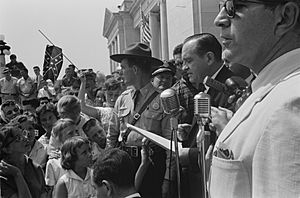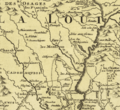History of Arkansas facts for kids
The history of Arkansas started thousands of years ago when the first people arrived in North America. Many Native American tribes used Arkansas for hunting. The main tribe was the Quapaw, who settled near the Arkansas River. Early French explorers gave the area its name. "Arkansas" comes from an Illinois language word for the Quapaw people. This is why "Arkansas" sounds different from "Kansas" even though they are spelled similarly.
What was once a wild land for trappers became part of the United States in 1803. This happened through the Louisiana Purchase. Later, it was known as the Arkansas Territory from 1819 to 1836.
Arkansas became the 25th state on June 15, 1836. It grew rich from large farms called plantations. These farms depended heavily on slave labor. After the American Civil War (1861–1865), Arkansas was a poor rural state. Its economy mostly relied on growing cotton.
In the late 1800s, the state created laws that separated African Americans from others. These laws also made it very hard for them to vote. These rules lasted until new federal laws were passed in the 1960s. During the Civil Rights Movement in the 1950s and 1960s, Arkansas, especially Little Rock, was a key place for efforts to integrate schools.
The state's economy began to improve during and after World War II in the 1940s. In the 1960s, the retail company Walmart started in Arkansas. Its headquarters are in Bentonville. Walmart later became the world's largest company by income. Many Arkansas political leaders became famous in the 1900s. This included Bill Clinton, who was Governor of Arkansas before becoming the 42nd President of the United States.
Contents
Early History of Arkansas
Ancient Times
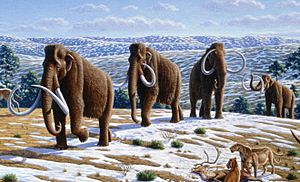
Around 11,700 B.C.E., the first people lived in the area we now call Arkansas. They came across a land bridge from Asia.
These early people likely hunted woolly mammoths. They would chase them off cliffs or use sharp tools called Clovis points. As the last ice age ended, major rivers thawed, and people also began to fish.
Forests started to grow around 9500 BCE. This meant more plants for people to gather. Simple containers became important for storing gathered food. Since mammoths died out, hunting bison and deer became more common. These early Arkansans probably lived in main camps. They would leave for hunting trips that lasted months.
Farming and Villages

Further warming led to the start of farming in Arkansas around 650 BCE. People cleared areas to plant crops. Native Americans began to form villages around these clearings.
The Native American groups living in Arkansas before Europeans arrived were the Quapaw, Caddo, and Osage Nations. During the time Arkansas was a territory, some of the Five Civilized Tribes also lived there as they moved westward.
European Explorers Arrive
The first European to reach Arkansas was the Spanish explorer Hernando de Soto in the mid-1500s. Arkansas is one of many U.S. states formed from land bought from Napoleon Bonaparte in the Louisiana Purchase. Early Spanish or French explorers gave the state its name. It likely came from an Illinois word for the Quapaw people.
The first European settlement in Arkansas was Arkansas Post. It was started in 1686 by Henri De Tonti. The post closed for a while but was reopened in 1721 in the same spot. It was located slightly upriver from where the Arkansas River meets the Mississippi River. This remote post was a busy place for trade. It was also a home base for fur trappers in the area to sell their goods.
Becoming a Territory and State
The area became the Arkansas Territory on July 4, 1819. Arkansas was then admitted to the Union as a state on June 15, 1836. It was the 25th state and the 13th slave state.
Arkansas created two banks during its first legislative meeting. These were the State Bank and the Real Estate Bank. Both banks failed within ten years. The money they owed became part of confusing legal problems. These were called the "Holford Bonds" because they ended up with a banker named James Holford in London. For many years, people in Arkansas argued about whether these bonds were a real state debt and if they should be paid back.
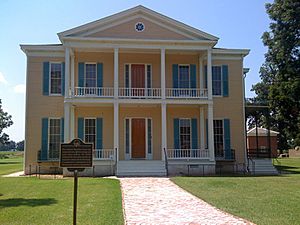
Arkansas played a big part in helping Texas fight for its independence from Mexico. Arkansas sent troops and supplies to Texas. The town of Washington was close to the Texas border. This made it important during the Texas Revolution of 1835-36. Some say that Sam Houston and his friends planned the revolt in a tavern in Washington in 1834. When fighting began, many volunteers from Arkansas and other eastern states passed through Washington on their way to Texas battlefields.
When the Mexican–American War started in 1846, Washington became a meeting point for volunteer soldiers. Governor Thomas S. Drew asked the state to provide soldiers for the United States Army. Ten companies of men gathered there. They formed the first Regiment of Arkansas Cavalry.
The Civil War in Arkansas

Arkansas did not want to join the Confederate States of America at first. But after United States President Abraham Lincoln asked for troops to fight the Confederate attack on Fort Sumter, Arkansas changed its mind. The state did not want to fight against its neighbors. So, it left the Union on May 6, 1861.
Arkansas was not a main battleground, but many small battles happened there during the American Civil War. When Union forces captured Little Rock in 1863, the state government moved to the town of Washington in the southwest.
Some important people from Arkansas during the Civil War included Confederate Major General Patrick Cleburne. Many thought he was one of the best Confederate commanders. He was often called "The Stonewall of the West." Another notable person was Major General Thomas C. Hindman. He was a former U.S. Representative. Hindman led Confederate forces at the battles of Cane Hill and Prairie Grove.
Late 1800s in Arkansas
After the war, under the Military Reconstruction Act, Congress allowed Arkansas back into the Union in June 1868. With the right to vote, freed African American men became very active in state politics. From 1869 to 1893, more than 45 African American men were elected to the state legislature. They were already leaders in their communities, often ministers or teachers.
In 1874, a conflict called the Brooks–Baxter War shook Little Rock. This was a fight over who was the legal governor of the state. President Ulysses S. Grant ordered one of the leaders, Joseph Brooks, to make his supporters leave. This settled the dispute.
In 1881, the Arkansas state legislature passed a law. This law set the official pronunciation for the state's name. This was done to end a big argument about it.
In the late 1880s and 1890s, the Democrats worked to keep their power. They wanted to stop African Americans and poor white farmers from working together. This was because of tough times for farmers. In 1891, state lawmakers passed a law that required a reading test to register to vote. More than 25% of the people could not read or write at that time. In 1892, the state passed a change to its constitution. This change required people to pay a tax to vote and live in the state for a certain time. These rules greatly reduced the number of African Americans and poor white people who could vote.
By 1900, the state Democratic Party began using "all-white primaries." This meant only white people could vote in the primary elections. These primaries became the only important elections. The Democratic Party winner always won the main election. This closed another door for African Americans. In 1900, African Americans made up 28% of the state's population. Together with poor white people, more than one-third of citizens could not vote. Since they could not vote, they also could not serve on juries. They were shut out of the political process.
Arkansas in the 1900s
The Great Migration
Many African Americans moved from the South to the North and Midwest in the first half of the 1900s. They were looking for better factory jobs. This move was a way to find a better life where they could vote and be full citizens. Changes in farming also meant fewer farm workers were needed. Thousands of people left Arkansas. During World War II, African Americans also moved to California. There were many good jobs in defense factories there.
Civil Rights Movement
In one of the first big cases of the Civil Rights Movement, the Supreme Court decided in Brown v. Topeka Board of Education (1954) that separate schools for different races were against the law. Both of Arkansas's U.S. Senators and all six of its U.S. Representatives signed a paper called the Southern Manifesto in response.
The Little Rock Nine event in 1957 brought Arkansas national attention. This happened at Little Rock Central High School. The Little Rock School Board had decided to start integrating schools. But people who wanted to keep schools separate physically blocked nine black students from entering the school. These students were chosen by the NAACP. Governor Orval Faubus sent the Arkansas National Guard to support those blocking the students. He only backed down after a judge ordered him to remove the Guard.
White crowds started to riot when the nine black students began attending school. President Dwight D. Eisenhower sent the 101st Airborne Division to Little Rock. He also put the Arkansas National Guard under federal control. This was to protect the students and make sure they could safely go to school. Little Rock's four public high schools closed in September 1958. They reopened a year later. All grades were finally integrated in the fall of 1972.
Bill Clinton
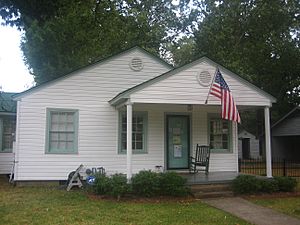
Bill Clinton, who was born in Hope, Arkansas, served almost twelve years as the 40th and 42nd Governor of Arkansas. He was then elected the 42nd president in the 1992 election. He was reelected in 1996 and served as president until January 2001.
Changes in how people viewed race and the growth of jobs have led to a New Great Migration. This is where African Americans are moving back to cities in the developing South. This is especially true for states like Georgia, North Carolina, and Texas. These states have created many jobs in new industries.
Images for kids
-
A map of the region in Louisiana, 1687
-
Colbert's raid on Arkansas Post in 1783
-
The United States, with the Louisiana Purchase overlaid
-
Map of the United States showing Arkansaw Territory, 1820
-
The Indian Removal Act resulted in the movement of several Native American tribes and the Trail of Tears.
-
The Turning of the Tune: Traveller Playing the "Arkansas Traveller", lithograph by Currier and Ives, 1870
-
Battle of Pea Ridge in March 1862
-
Price's Missouri Raid in the fall of 1864
-
Regimental Colors of the Third Arkansas (1863–1865)
-
A drawing of U.S. Colored Troops mustered out at Little Rock, 1866.
-
Anthony House – Scene of the 1874 conflict between Brooks and Baxter.
-
University of Arkansas, founded by the General Assembly in 1868, is one of many public universities in the state.
-
Wife and children of a sharecropper in Washington County, Arkansas, c. 1935
-
Man with child at a meeting of the Southern Tenant Farmers Union, 1937
-
Time magazine (October 7, 1957), featuring paratroopers at Little Rock.
See also
 In Spanish: Historia de Arkansas para niños
In Spanish: Historia de Arkansas para niños




